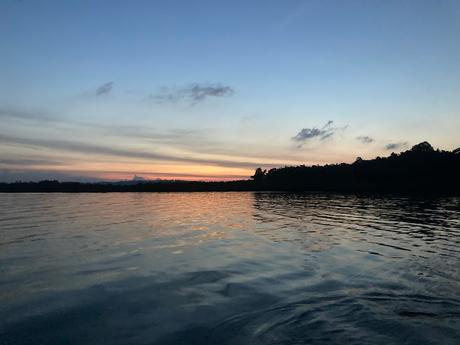Imagine, for one, a ten-hectare woody parcel of land, next imagine it's an island with hardly any people living on it and very few inhabitations around the island, so in the night the sky lights up with stars brighter than the horizon. Add to that mango, jackfruit, betelnut, pepper, and coconut plantations, to name a few, and a beautiful home to stay in. Lastly, add a house at the end of a pier, only accessible by a boat, following the 2014 tsunami. That's precisely what the Noble island is—that and a lot more.

We had a day to spend at Port Blair and we asked Tanaz and Shiraz Noble if we could visit the island they own and kayak around it and they were happy to take us. What followed was a drive across half of Port Blair town to an approach point where the boat awaits to take us there. Right at the approach, things change drastically; plastic waste and rubble piled up close to the approach but as you walk the last few metres close to the waiting boat, things get serene quite immediately. There are only the sounds of the mellow waves and the view of Rhizophora and their majestic aerial roots at the edge of the Noble island; they look a bit like J R Tolkien's ents with long roots as tall feet.
Once we got to the island, Tanaz and Shiraz briefed us about the safety issues related to kayaking and how to make the paddle strokes hydrodynamic and efficient. Crossing the 10-degree channel, from Barren island to Havelock, and Rangat to Havelock are just some of Tanaz's amazing kayaking feats. Off we went for a short tour of the island.
Paddling correctly took a little while. Mahesh Sankaran was on my kayak and quite often our paddles would bump since we were not synchronised, but soon it all came together. Often, we paused to hear the enthusiastic information about how to identify and understand the different mangrove species; there were two species of Rhizophora, which are often at the mangrove front since with aerial roots they can tolerate higher tide variations than other species, a species of Avicennia found closer to the shore and Sonneratia species with snorkel roots, Ceriops with interesting 'knee roots', and Bruguiera, also with short knee roots. Often, while identifying terrestrial species, we look at the bark and leaves but with mangroves the roots themselves are a great starting point. This information will certainly change the way I view and understand a mangrove forest in the future.
After an hour or more of kayaking occasionally seeing the kingfishers, the whimbrels, the teals, and mudskippers we took a look at the house on the farm. It had solar lights, rainwater harvesting, wifi, a kitchen complete with all necessities, a large 'working' room, and a bedroom, overall, a dream home!
We spent about three hours in all in the island, and on the way out got a look at the 'water house' that is only accessible through a ferry, another basic house with a fantastic view and vibe. Someday, would love to stay there and appreciate the view, the waters, the forest, the plantations, and the island more. Until then, it is nice to know that such a 'noble' island exists!
Do take a trip to the island to see the ents and the other plants and the birds, and experience the calm of water and the conversations with the lovely people.

